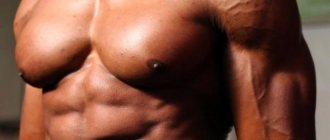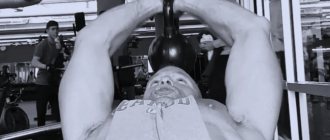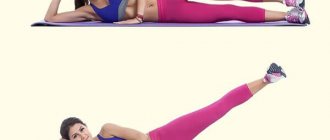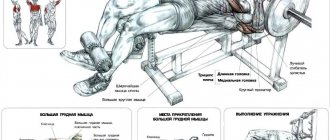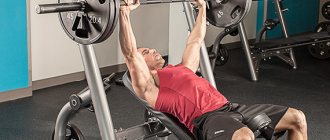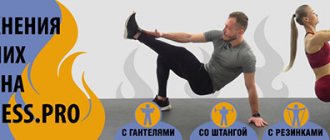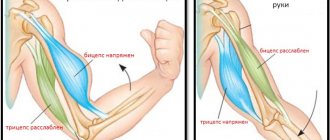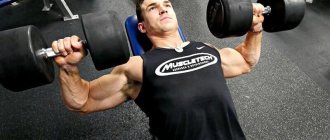Developed pectoral muscles emphasize the overall athletic build. Much in this regard depends on genetics, but it is quite possible to increase their volume.
You need to choose the right exercises, as well as follow general recommendations regarding gaining muscle mass, affecting whole-body training, regimen and nutrition.
It is much easier for men to pump up their chest muscles than for women. Women will not be able to increase the volume of this area through physical exercise, but they will tighten their muscles and tone them.
In any case, a special approach to training and other factors is required.
How to work correctly with the muscles of the sternum with a barbell, dumbbells, and parallel bars
When starting chest development exercises, it is important to understand how to properly load the muscles to get maximum benefit. There are a few tips to follow:
- First of all, perform exercises with a barbell, for example, a bench press or with dumbbells (dumbbell press);
- As auxiliary movements, you can use fly-outs or isolated exercises on simulators;
- to increase volume you need to do 2-4 exercises of 6-15 repetitions. You should not focus on high-repetition movements;
- to develop the chest, a wide and medium grip is used; with a narrow grip, the triceps are more involved in the work;
- parallel bars can be used as a main and auxiliary exercise.
The technique used to perform the exercises will depend on the type of movement. So, for example, the bench press is performed as follows:
- the athlete lies down on the bench so that his eyes are opposite the bar;
- grab the barbell with your hands, wide or medium, evenly from each edge;
- the rod rises from the racks independently or with the help of a belayer;
- first movement - the barbell lowers to the chest while inhaling;
- after a short pause, the projectile rises upward, with a sharp movement with maximum effort, while exhaling;
- the movement is repeated the required number of times.
The dumbbell press is performed in the same way, the only difference is that the dumbbells are either held straight, or their trajectory changes when moving up and down (at the top point they stand “in a row”, and at the bottom they are parallel to each other).
When doing dips, you can either use additional weight or do without it, it all depends on your level of training. The technique is approximately as follows:
- the athlete stands near the bars and climbs on them with outstretched arms;
- first movement - the body lowers as low as possible while inhaling;
- second movement - the body rises as you exhale.
Important! During exercises on the uneven bars, your arms should be kept straight, without allowing vibrations in the area of the elbows. With a wide stance, the load falls more on the pecs, and with a narrow stance, it shifts to the triceps.
At the beginning, it is quite difficult to understand how to do it correctly with a barbell, how to do it correctly with dumbbells and on parallel bars, so it is better to use minimal weights until you fully master the technique. This will ensure minimal risk of injury.
Be sure to watch: Gallery image with caption: “Making” breasts without surgery and diets: exercises for the sternum muscles for women and girls Gallery image with caption: Recommendations on how to pump up a girl’s breasts and quickly tidy up a man’s sternum muscles at home Gallery image with caption: Features of chest-back training in one day: exercise program for beginners and advanced athletes Gallery image with caption: Exercises that will help pump up the chest muscles for a man
Preventing injuries when training the pectoral muscles
Bench presses and push-ups are not considered traumatic exercises. What can we even talk about about pullovers, hand pinch-ups, and so on. But still, injuries sometimes happen. Most often, accumulated fatigue makes itself felt. A person has something in pain somewhere (shoulder, elbow, wrist), he courageously endures the pain, believing that the sport will reward him for his efforts, but instead, benching becomes more and more difficult, and the training weights begin to “grow down.”
You should never train through pain if this pain is in the ligaments or joints!
In order to avoid getting into such situations, you should correctly distribute the load and periodically give yourself a rest, and not when it’s really hot. You also need to learn to distinguish between muscle pain and pain in the joint-ligamentous system. If you feel discomfort in your ligaments or joints, you should go to the doctor instead of the gym, and you need to do this quickly, before this whole mechanism begins to bend.
The second point is related to insufficient warm-up and violation of technique. When a heavy barbell falls on your chest, it really hurts, and it’s better not to let that happen. However, this kind of extreme happens very rarely. More often you can see how a person presses, wriggling his whole body, like a snake. Or from the very beginning he is accustomed to lifting his butt off the bench and only due to this he lifts the barbell. This is fundamentally wrong, and this kind of deception is punishable. Today, having torn off his butt, the guy squeezed out a couple of times more (what a joy), but at the same time, he blocked his growth prospects for the future.
Be that as it may, training the pectoral muscles should certainly be included in any training program. Training your chest is not at all difficult, the main thing is that the training is structured correctly.
Learning to do push-ups from zero to maximum Strengthening the upper part of the pectoral muscles
What exercises for home and gym should be included in the program for pumping up the pectoral muscles?
Pumping the chest muscles and working on mass is carried out through a series of exercises. The most popular basic movements when training in the gym are:
- bench press on a horizontal bench;
- incline bench press;
- dumbbell press on a horizontal and inclined bench;
- raising dumbbells on a horizontal and inclined bench;
- presses in simulators;
- dips;
- crossover.
This is the main backbone on which the training program is built.
Breast development at home is done using push-ups. They should be the main exercise. Such exercises are performed according to various schemes, different positions of the arms and legs are combined, and additional weight is used (for example, in a backpack).
You may also be interested in: Chest exercises at home
Tips on exercise technique
Pullover with dumbbells
Although the pullover also loads the latissimus dorsi muscles, this variation also pumps up the pectoral muscles. As you pull the dumbbell forward, imagine that you are squeezing it and pushing it away from you. This may take a little practice, but this tactic will keep the load on the pectoral muscles. You will feel your chest working.
Feel the characteristic tension in your upper body. Hold it for as long as possible as you reach your arms back. Just don't let your hands go past your ears.
It is advisable to contract the chest muscles as much as possible; if you go too far, then the latissimus dorsi muscles will become tense, and we don’t need that here.
If necessary, reduce the weight or perform the exercise more slowly until you feel a full chest contraction during the pullover.
Incline Dumbbell Press
Use the first set as a warm-up or stretch to prepare your muscles. Save the heavy weights for the next three sets. The dumbbell has its advantages over the barbell - it will allow you to go a little further at the bottom of the amplitude, stretching the muscles after each contraction.
Dumbbell raises
You'll have to lighten the weight a little, but this will only benefit your chest as you'll get a slight stretch after each rep. Resist the temptation to immediately increase the weight after completing a rep. You can increase the weight only when you can perform 15-20 repetitions without problems.
Incline flyes target the upper chest as well as the anterior deltoid. If you feel like your biceps are doing most of the work, rotate your palms inward or outward, whichever works your chest better.
Dumbbell Isolation Press
Another benefit of dumbbells is that you can work each side of your body separately. In this exercise, you will lift both dumbbells, then hold one hand down while lowering the other, rotating your palms as you lower the dumbbell. Make sure the dumbbell is directly at chest level before you lift it back up.
You can use heavier dumbbells as long as you can do 15-20 reps. Select a weight with which you can perform the specified number of repetitions.
Performing the exercise with one arm also engages the stabilizing muscles. But the exercise must be carried out carefully. Follow the technique strictly.
https://youtu.be/un80pPErwJE
How many times a week should you exercise
When creating a training program, you need to determine how quickly the muscles recover after performing exercises. These processes are individual in nature, some need a week to recover, others need several days. Without going into details of the stages of the process, we can conclude that it is necessary to perform movements on the pectoral muscles once or twice a week.
At the beginning of training, it is best to base yourself on your own feelings. The muscles will ache, this is a normal reaction to training. In case of acute pain, it is not worth repeating the load on the muscle group; it is better to let the body complete the processes.
How to properly learn to shake your butt
Regardless of the size of the buttocks, they can be very successfully moved to music. But for it to be beautiful and impressive, it is necessary first of all to get them into shape. Only toned, smooth and beautiful butts can shake successfully and elegantly. Knowing how to shake your butt requires practice and a mirror, as well as pre-training your glutes. It wouldn’t hurt to tone the skin on the loin if you are dancing in short shorts, skirts or a swimsuit.
In the American style, these body movements are called “Booty shake dance,” that is, “dance of shaking buttocks.” Learning this from video tutorials is difficult, but possible. The biggest problem with this is that the trainers perform the actions too quickly and it’s difficult to repeat. But there are some instructions on how to learn to shake your butt beautifully, even if it seems to be missing.
View gallery
Program for pumping the muscles of the sternum
Training should be based on a scheme, that is, a training program. The plan is drawn up at the beginning of classes and adjusted based on your own feelings, progress, recovery speed and other factors.
The plan will be different for beginners and more experienced athletes. At first, it is recommended to perform fewer exercises, giving preference to basic, multi-joint movements. Then the isolated ones are included, and other diversity is introduced.
For newbies
When we pump our chest, other muscles come into play. This factor must be taken into account when creating a training program. For beginners, it is better to train according to the principle of a three-day split, focusing each workout on two or three muscles.
A sample plan looks like this:
| Workout 1 | Legs and shoulders. 2-3 leg exercises (for example, squats, lunges and machine leg presses), then 2 shoulder exercises (standing barbell press and seated dumbbell press) for 3-4 sets of 6-12 reps. |
| Workout 2 | Chest and triceps. Bench press 4 sets of 8-15 reps. Incline dumbbell press, 3 sets of 8-15 reps. Dumbbell flyes, 3 sets of 10-12 reps. Triceps on the block, 4 sets of 10-15 reps. Dips, 4 sets of 10-12 reps. |
| Workout 3 | Back and biceps. Option: deadlift, barbell row, pull-up, biceps curl, dumbbell curl on a Scott bench. 3-4 sets of 6-12 repetitions. |
Training can be alternated differently. For example, the pecs can be combined with the back, shoulders, and so on. The main thing is that the body has time to recover. Before pumping the lower chest separately (or the upper), it is worth paying attention to the overall development, then the weaknesses will become clear, and the program will change depending on them.
For advanced
More experienced athletes can pay more attention not to general training, but to individual parts of the pectoral, isolating movements. But before training the lower part of the sternum muscles or, conversely, the upper part, it is worth performing basic exercises, only then moving on to special movements.
A chest/triceps training day might look like this:
- bench press, 4 sets of 10-12 reps;
- dumbbell press, 3 sets of 10-15 reps;
- Incline bench press, 3 sets of 12-15 reps;
- crossover, 3 sets of 12-15 reps;
- French press, 4 sets of 12 reps;
- bent over triceps extension, 3 sets of 10-12 reps.
Another training option for combining the load on the chest and shoulders is as follows:
- bench press with a barbell, 4 x 10;
- Smith machine press, 3 x 10;
- crossover, 3 to 12;
- dumbbell flyes, 3 to 12;
- standing barbell press, 4 x 12;
- Arnold press, 4 to 12-15.
There are quite a lot of options. For example, a five-day split can be used, when training is carried out 5 times a week, then a separate day is devoted to the chest, approximately 5-6 movements are performed.
You may also be interested in: How many times a week should you exercise?
Mixing in a crossover through the upper blocks is an isolating exercise.
Mission of the exercise: pump up the bottom, middle and inner edge of the chest. Level of training: intermediate and above. Number of approaches: 3-4 sets of 10-15 repetitions.
Technique:
1) Take the D-shaped handles of the crossover, which pass through the upper blocks, with an overhand grip. We stand in the middle of the machine and take a small step forward - this will allow you to keep your body more stable.
2) Maintain a natural curve in the spine, tilt the torus a little forward, 15-30 degrees.
3) Spread your arms to the sides as wide as possible and lower them down a little, but at the same time the load should be removed from the supports, and your elbows should be at the same level as your shoulders and slightly bent, with your palms facing the floor. Perform movements only in the shoulder position.
4) Take a deep breath and fixate your breathing, pull the handles with your muscles until they touch, or even more, so that they go beyond each other (crossing your arms).
5) As soon as you reach the handles towards each other, exhale, try to tense your chest muscles as much as possible. Then return to the starting position.
https://youtube.com/watch?v=IqFfik_R6l0
How to quickly develop muscles: pro tips
The development of chest muscles requires a special approach. Progress can be achieved both at home and in the gym, but, according to professionals, a program for pumping up these muscles should preferably contain exercises with a barbell and dumbbells.
Professionals, especially coaches and experienced athletes, advise starting movements with heavy exercises that affect the chest as a whole and do not focus on any part. This is a barbell press, dumbbells, parallel bars, and in home exercises - push-ups. For women, it is better to do incline presses to develop the upper chest, which will allow it to “tighten” it somewhat.
Important! According to the pros, it is better to complete classes with isolating movements, which will help consolidate the result. Also, do not forget about the restoration of the body, which is carried out through proper nutrition and adherence to the regime.
Alexander Kodzoev, bodybuilder
A well-known bodybuilder in Russia uses a five-day split program, devoting a separate day to the chest. Depending on the season, either heavy multi-joint exercises or isolation exercises can be performed on this muscle group.
He advises non-professionals to focus on presses, as they will allow you to work the chest as a whole and only then move on to isolated movements. It is also worth correctly distributing the load, training the body as a whole, comprehensively and harmoniously, and not focusing only on chest training.
Dmitry Yashankin, bodybuilder
Dmitry Yashankin is known not only for his professional career, but also as the author of many training videos and techniques. He advises approaching body training consistently, taking into account the characteristics of the body, strengths and weaknesses. But in any case, you need to train the entire body.
In his opinion, it is better to train the chest with bench presses, then move on to movements on machines and other auxiliary exercises. For beginners, it is better to perform 2-3 exercises and allow the body to recover well, only strengthening the program over time.
Ekaterina Usmanova, fitness bikini
The athlete not only competed in fitness bikini, but also successfully participated in bench press competitions. She believes that even girls should do bench presses, as it will help harmoniously develop muscles and tighten their chest. Particular attention should be paid to the bench press of barbells and dumbbells on an incline bench, but also include fly-outs and movements on machines in the program.
"Drying"
It is necessary to train your chest even when you are trying to burn subcutaneous fat. But getting rid of excess weight is not a matter of a training program, but a matter of dieting for weight loss. In this case, a sports diet would be the most appropriate; as for the pectoral muscles during this period, the training program should be aimed at preserving muscles, and not at getting rid of fat, and it is even more pointless to try to pump up the chest.
Forget about aerobic exercise! If you do not take anabolic steroids, you will simply “burn” all your muscles. On the contrary, you should train with heavy training weights. It is best to do the bench press for 6-8 reps. Otherwise, in conditions of calorie deficit, the body will use muscle rather than fat as energy. Muscles are full of glycogen, so if you don’t force your body to think that muscles are vital to it, then it will “eat” them first.
Build muscles
Main conclusions
You need to train your chest consistently and in a variety of ways. It is necessary to provide the body with a load adequate to the level of training, and it should increase over time, gradually. It is best to choose basic, heavy movements, especially at the beginning of training.
The best exercises for chest development are considered to be the bench press, both barbells and dumbbells, as well as flyes, dips and a whole range of exercises on machines. Don’t forget about training the muscles that are auxiliary for chest movements, such as the back, triceps, abs and shoulders.
Pump up your chest: strength
It is necessary to train the strength of the pectoral muscles by performing basic exercises, but unlike mass training, in a low frequency number of repetitions. We're talking about the bench press. In this case, the exercise technique will be specific, you will have to make a bridge, bring your shoulder blades together, turn your elbows towards the body, lowering the barbell, you will touch the solar plexus, and your hands will be pressed to the body.
With this technique, most of the load will be received by the triceps, latissimus dorsi, legs and shoulders, which does not really help pump up the chest. But you will be able to lift more weight, which will stimulate your fast-twitch muscle fibers to grow. Often bodybuilders neglect this technique, because this is an exercise for powerlifters, but they do it in vain. The fact is that micro and macro periodization are very useful.
The more varied load you give your muscles, the more effective the workout. The body has to adapt, so you are less likely to hit a plateau. Since the load is different, the chance of overtraining is also less. Moreover, by increasing strength indicators, you will be able to more easily progress the load when training your chest for weight. Therefore, it is easier to pump up your chest by training different muscle qualities than to “pound” the same training program.
intimate conversation
Did you know that you can noticeably improve the missionary position if you simply put a pillow under your butt?
I know how much you hate the missionary position. Missionary position only gives you pleasure in your dreams, when you are looking at your lover's shoulders or looking at the ceiling and dreaming about what things you are going to buy online.
But, believe me, this pose is quite good. Lie on your back and take the fluffiest pillow. Place it under your butt. This will elevate part of your body and encourage deeper penetration. Wrap your legs around your partner for deeper penetration.
This position gives you easy access to your clitoris, starting to rub it, since it is very difficult to achieve an orgasm from penetration alone. It's time not to be shy.
Alternating breasts when feeding
The position of the most widespread maternity program, which is widely broadcast everywhere and everywhere, is extremely clear: any pregnant woman who has just given birth always owes everyone. Regardless of race, age and heredity, it is prohibited to gain more than 12 kg during pregnancy. Regardless of race, age and heredity, childbirth should be completed within a certain number of hours. Debts are passed on to the child: just after being born, he must gain some, suck out some during feeding, and then sleep some. So-called natural parenthood may seem liberating... Often it is, although there are still enough people trying to make the mother an eternal debtor. On the one hand, they say: “Listen to your gut!” On the other hand - suddenly! – it turns out that a pregnant woman should go do prenatal yoga, regularly swim in the pool, and whatever else. Some midwives require the pregnant woman to visit the bathhouse. What should those who don’t like baths do? Apparently, look for another midwife. There is nothing wrong with yoga, swimming, or a bath if a woman is drawn to classes by her own desire (intuition or something else), and not by the instructions of third parties.
After giving birth, it turns out that now the responsibility has become planting and alternating breasts. I would like to talk about the latter in more detail.
So, the gist of this advice is to give one breast for a few hours and then only offer the other. Again, no allowance is made for race, age, heredity... Well, you get the idea. For example, breast capacity can vary from woman to woman, and appearance does not always indicate capacity. That is, the first thing that suggests itself - “a lot of milk can potentially accumulate in a large breast, and little in a small one” - is incorrect. The ratio of adipose and glandular tissue cannot be determined by eye. Breast capacity has nothing to do with milk quantity. A breast with a small capacity will simply begin to drum during the time that one gland, in theory, should rest (2-3 hours). Perhaps the feeding option in this case is to frequently change the breast (including during one feeding, when the right one is given first, then the left one, then the right one again, and so on).
In order to “make life easier” for the mother of a small child, she is offered to buy a milk (nursing) bracelet (a budget option is to attach a pin to the bra on the appropriate side). The bracelet looks something like this.
A woman marks the time using a slider. Left/Right – right and left chest, respectively. Returning to biology, instincts and maternal instincts: imagine, for example, a cat. The cat has two ridges of mammary glands, each with four pieces. That is only eight. And four paws. And an indefinite number of kittens. What will happen to a cat if she is asked to alternate breasts? Does she have enough paws for bracelets? Is there any point at all in imagining such an absurd picture? Why then do we look for it in the case of a human woman?
Indeed, it often happens that the first arrival of milk after childbirth is accompanied by unpleasant phenomena: a feeling of heaviness and fullness in the chest, fever, chills, heavy leakage (normally, another development of events is also possible, when colostrum is replaced by milk almost imperceptibly). It seems that such a tiny child cannot cope with a huge amount of milk, which is why terrible lactostasis will certainly come, followed by inevitable mastitis. Those women whose milk came within the walls of the maternity hospital can be told about all the delights of mastitis, and also about the need to develop (open) tight ducts, for which they have a special person who strains until bruises (I am not exaggerating). Oh, where are those specialists who strain the representatives of other biological species? How did people with such defective tight ducts not become extinct along with the mammoths? In addition to pumping, they may also offer pills under the pretext: “We won’t discharge you with such breasts!”
If self-harm is avoided, the situation usually normalizes fairly quickly. The milk contains a lactation inhibitor, which adjusts the amount of milk produced to the individual baby (or babies). Subjectively, the feeling of fullness in the chest remains, but there is no longer any distension. Usually, it is in these first days after birth that there may be a need to pump milk until relief is achieved, then the body copes on its own, ceasing to produce excess.
What should a woman focus on? Overall, the best thing is to listen to your child and yourself. All these rules with alternations or “one feeding - one breast” were created for a certain spherical woman in a vacuum, they are not universal. They may suit you, but not your neighbor. The pin along with the bracelet will in every possible way show you that you need to give the baby the right breast, but you feel more fullness in the left and want to offer it. The most logical thing to do here is to throw out the pin and take off the bracelet.
The extreme level of such devices are devices that analyze how much milk the baby has sucked from the breast during feeding. Compared to them, the bracelet is a harmless accessory. In my opinion, they appeared because the medical community does not differentiate between breastfeeding and pumped milk.
For example, a woman breastfeeds on demand, that is, the baby is latched at the first sign of readiness to suck, he does not have breast substitutes (pacifiers and bottles) and the duration of feeding is determined by the child (he lets go himself). Does this woman know what composition of milk the baby is sucking at a given time? Is it the front one, the back one, or does her milk not have time to separate into fractions at all? Is this kind of information necessary at all?
There are more nuances with express feeding. Firstly, they usually express according to a schedule, which means that the milk is most likely divided into front and back. Secondly, foremilk is released easily, but hind milk is much more difficult. Those who are breastfeeding should know this feeling: the breast seems empty, but the baby sucks and swallows, and he can suck like that for hours. In expressed milk, anterior-posterior imbalance is much more likely. The result is that the child has a stomach ache or weight gain is lower than desired. That is, the very appearance of the first intervention (pumping) entails consequences.
The same thing with feeding, which seems to be breastfeeding, but is far from natural: by the hour, using a pacifier/water bottle, with feeding for a certain number of minutes. The child wants to suck, but is not allowed to do so, being offered a pacifier. As a result, milk accumulates in the breast and separates into front and back. The inhibitor also accumulates in the milk, as a result of which the brain receives a signal: “there is a lot of inhibitor - there is a lot of milk - you need to produce less.” When feeding time finally arrives, the baby actively sucks foremilk for the first few minutes. Subjective breast fullness disappears, it seems that the baby is sucking empty, which is interpreted by many as pampering. “What are you feeding there? There’s no milk left there anymore!” The result is that the baby is deprived of hindmilk or receives significantly less of it. And the consequence is exactly the same as when feeding with expressed milk: tests show lactase deficiency (and lactase preparation is also suggested to be given hourly), low weight gain, stomach pain and everyone panics. And the conclusion: “Your milk is not suitable for your baby because it is too watery!”
In defense of the bracelet and pin: they can help with hyperlactation, that is, in a situation where too much milk is produced and when it is desirable for the inhibitor to tell the brain: “Don’t cook the pot!”
Daria Malynova
22-10-2015

